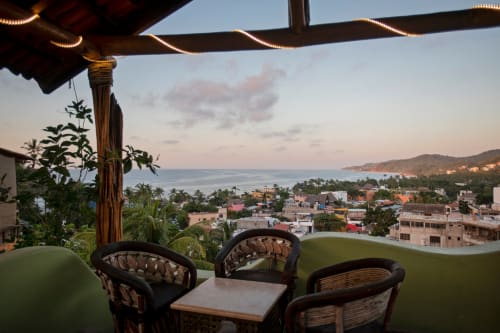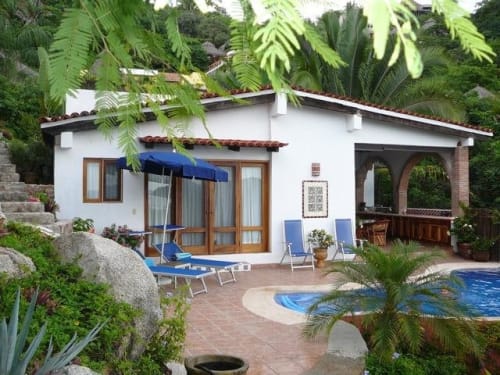SayulitaLife.com members can easily save favorites for vacation rentals, local businesses, real estate and more.
Sign In Create free accountList Your Property
Uncrowded Pacific hamlet could become Mexico's next hot stop-Rutland Herald
Uncrowded Pacific hamlet could become Mexico's next hot stop
Published on: 03/20/06 at www.ajc.com. and in the Rutland Herald See entire article
• What to know if you go
SAN FRANCISCO, Mexico — Maybe it was the impossibly bright orange sunset over the Pacific Ocean, the sound of waves crashing onto the shore, briefly disturbing the peace and the silence around us.
Accommodations in the area range from cheap to luxurious. Among them is Villa Amor, which has filtered water and equipped kitchenettes.
Or it may have been the eclectic crowd — old hippies, yuppies and the ultrarich — enjoying the isolated innocence on an unspoiled Mexican beach.
Whatever it was, I couldn't avoid a creeping realization: I didn't miss Cancun, its blindingly white sandy beaches, or the turquoise Caribbean waters. And just forget Acapulco and its nonstop nightlife and foul bay.
I had found a new paradise, and just in time. I'd thought I'd visited every beach in Mexico. I had grown jaded about many places where you arrive eager to hit the water or relax and read a book, only to end up feeling cleaned out by resort operators and their hidden costs, such as the 5 percent cover charge just to dine. This quiet stretch of Pacific coast in Nayarit state renewed my faith.
A world away
I'm enjoying this place, just 45 miles north of Puerto Vallarta and a world away from Mexico's more well-known and crowded tourist destinations.
Before long, however, the inevitable pressure of beach-seeking humanity will be arriving by the planeload. The place is no longer a secret beyond the small but dedicated group of vacationers, the vast majority from California, who come back year after year to live a few days in simple luxury.
The northern rim of Bahia de Banderas has become an eclectic refuge for the pinchers of pennies and the deep pockets alike. Lodgings go for anywhere from $35 for a no-frills room in Cielo Rojo to $550 at the Four Seasons Punta Mita.
This windswept coast was once a string of remote fishing villages nestled by hilly jungles. But it's now a playground for jet-setters and surfer dudes alike, all chasing the next big wave. At once, a vivid reminder of Spain's Costa Brava and California's Santa Cruz.
Quiet jungle drew Californians
Nayarit state, made famous in the movie "Night of the Iguana," has been known as the jungle around Puerto Vallarta — for decades a principal destination for U.S. travelers from the West Coast. It was a small, unhurried resort area squeezed against the Pacific by tall mountains hiding the colorful but reclusive culture of Mexico's Huichol Indians.
The charming hamlet of San Francisco, known locally as San Pancho, won me over with its tropical beachfront and lush green hillsides of seemingly undisturbed parrots. It has some of the best bird and whale watching in the world.
It's off the beaten path and reflects a downshift tourism — a quieter and more relaxed environment. More important, it was the unusual, welcome hospitality offered by friendly locals who appear eager to embrace the transformation of this fishing village into a world-class resort.
Surfer haven
Its cobblestone streets and white sands call out for early morning or evening walks. It's also a surfer haven, this point proved by a travel companion who'd wake up at 5:30 a.m. to hit the waves. I preferred hiking through mountains, taking in the views and endless miles of pristine beaches along the Nayarit coast. Like the region itself, ours was a peaceful coexistence.
That doesn't mean that some aren't worried about losing a traditional way of life. They've seen what's happened to once-secluded Cancun, or Nuevo Vallarta. A local group of women is protesting to preserve public beach access they've always had before.
Yet change is coming: Both the federal and state governments are pumping millions of dollars into roads, electric lines and municipal water projects. They're creating what locals proudly call Mexico's next best tourism destination.
Among the projects: a new road to connect San Pancho to Sayulita, an indolent fishing village known for its surfer-worthy waves, and Punta Mita, where Four Seasons is the star attraction. It's one charming beach after another, interrupted only by tropical forests and mangroves. Farther inland are Nayarit's volcanic highlands and the cultural attractions and pristine beaches of Guayabitos and big-city Tepic.
I stood on top of a mountain, watching the sunset and Bungalow Lydia below us, taking in the whispering wildlife and hushed sounds, mindful that the secret will soon reach Texans, if it hasn't already.





